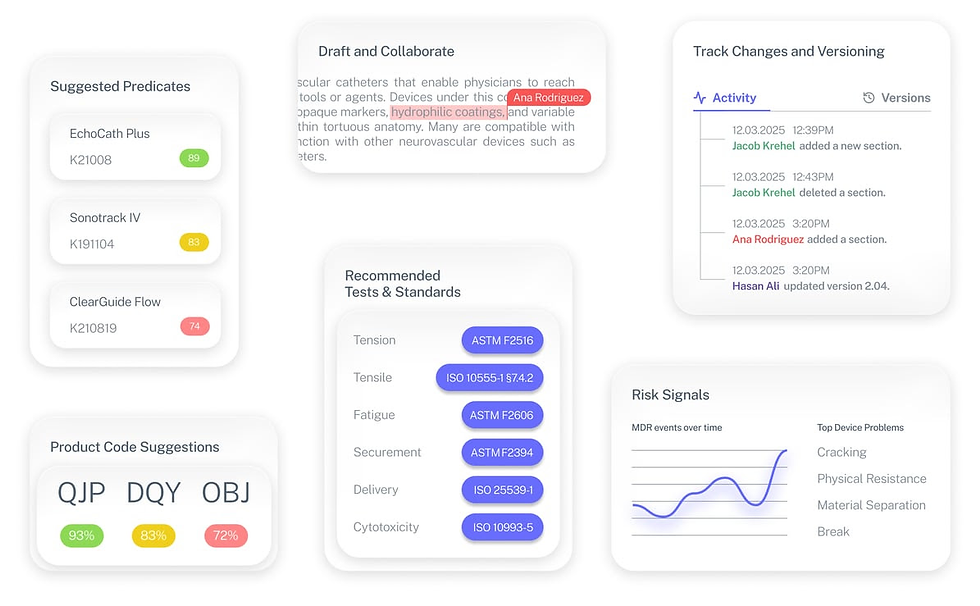FDA SaMD Pre-Submission (Q-Sub): When to Request & What to Include
- Beng Ee Lim

- May 22
- 4 min read
Updated: Sep 7
Use an FDA Pre-Submission (Q-Sub) when your SaMD has novel tech/claims, unclear classification/pathway, clinical evidence questions, cybersecurity/AI issues, or you’re planning a De Novo/510(k). Include a concise device overview, DSF/software summary, risk file highlights, proposed evidence plan, any PCCP concept (if AI), and specific, answerable questions.

What Is an FDA Pre-Submission (Q-Sub)?
A Pre-Submission (Pre-Sub) is a voluntary meeting with the FDA under the Q-Submission Program, offering early, non-binding feedback on your regulatory strategy.
Why it matters for SaMD:
Clarify your regulatory pathway (510(k), De Novo, PMA)
Validate Device Software Function (DSF) classification
Confirm data, labeling, and AI/ML documentation needs
Identify red flags before formal submission
When Should You Request a Pre-Sub for SaMD?
Here’s when a Pre-Sub is not just helpful—it’s smart:
✅ Novel or AI-Driven Features
If your software uses AI/ML, performs real-time updates, or lacks a clear predicate, you need to get the FDA’s take early.
✅ Unclear Classification
Still unsure if your software qualifies as a Device Software Function (DSF)? A Pre-Sub is where you sort that out.
✅ Complex Use Cases
Includes:
Combination products (e.g., SaMD + wearable)
Multi-region variants
Remote updates or PCCPs
✅ Labeling or Claims Questions
Want to say your software “predicts stroke risk”? Get FDA’s input before it becomes a clearance delay.
✅ Cybersecurity / SBOM
If your SaMD includes networked components or open-source dependencies, FDA will ask about your Software Bill of Materials (SBOM). Use a Pre-Sub to align on scope.
What Documents Should You Include?
1. Cover Letter + Questions List
The FDA requires a cover letter stating the purpose of the pre-submission clearly.
List the specific questions (pathway, PCCP, DSF, labeling).
2. Device & DSF Description
What does it do? What’s the architecture? What’s the intended use?
A detailed description of the device is mandatory.
This helps FDA understand the product context.
3. Risk Management Summary
ISO 14971-aligned
This should cover known hazards and mitigations to demonstrate safety considerations.
4. Verification & Validation Plan
Protocols
Metrics
Success criteria
Helps FDA assess your testing strategy and readiness
5. SBOM + Cybersecurity Documentation
List components
Threat model
Mitigation strategy
Address key cybersecurity concerns
6. Draft Labeling
Screenshots
User interface mockups
Instructions for use (IFU)
Clarify how the device will be presented to users
7. PCCP Outline (if AI is involved)
Describe intended updates
Safeguards
Performance guardrails
8. Sample Data Outputs
Input/output examples from your algorithm
Helps FDA understand how it functions in practice
What’s the Timeline?
Submission Acceptance (Up to 15 Days)
Once you submit your Pre-Sub package, the FDA reviews it within 15 calendar days to ensure everything is complete. If something’s missing, they’ll ask you to provide it before moving forward.
FDA Review Period (About 70 Days)
After acceptance, the FDA spends around 70 days reviewing your questions and materials. This is when they evaluate your device and prepare feedback.
Pre-Sub Meeting (Typically 60-75 Days In)
If you requested a meeting, it usually happens between 60 to 75 days after the FDA receives your complete submission. This is your chance to discuss your device and get direct feedback.
In total, expect the Pre-Sub process to take roughly 2.5 to 3 months. This timeline helps you plan your development and regulatory strategy effectively.
Starting early with a Pre-Sub can clarify FDA expectations and smooth your path to market—making the wait well worth it!
Common Pitfalls & Pro Tips
Watch Out for These Pitfalls
Unclear Questions:
If your questions to the FDA are vague, you’ll get vague answers. Be specific and focused to get the feedback you really need.
Incomplete Prep:
Missing documents or not having the right team members ready can slow things down. Make sure your materials are complete and your team is prepared.
Too Much Info at Once:
Don’t overload the FDA with every detail or feature. Keep it simple and highlight the most important points.
Ignoring FDA Guidelines:
Not following FDA’s expectations for SaMD—like risk management and software documentation—can cause delays.
Poor Follow-Up:
After the meeting, failing to document what was discussed or respond quickly to FDA requests can hurt your progress.
Pro Tips for Success
Ask Smart, Targeted Questions:
Focus on the big regulatory or clinical issues. Keep your questions clear and limited to a few key topics.
Speak FDA’s Language:
Use FDA guidance documents and terminology to help reviewers understand your approach.
Engage Early:
Submit your Pre-Sub when your device concept is clear but before everything is finalized. This helps reduce surprises later.
Have a Meeting Leader:
Assign someone to keep the discussion on track and make sure all questions get answered.
Take Good Notes:
Document the meeting carefully and summarize FDA feedback right away to avoid confusion.
Be Open and Flexible:
Treat the Pre-Sub as a conversation. Listen to FDA’s input and don’t hesitate to ask for clarifications.
The Fastest Path to Market
No more guesswork. Move from research to a defendable FDA strategy, faster. Backed by FDA sources. Teams report 12 hours saved weekly.
FDA Product Code Finder, find your code in minutes.
510(k) Predicate Intelligence, see likely predicates with 510(k) links.
Risk and Recalls, scan MAUDE and recall patterns.
FDA Tests and Standards, map required tests from your code.
Regulatory Strategy Workspace, pull it into a defendable plan.
👉 Start free at complizen.ai

FAQs
Q: Is a Pre-Sub mandatory?
No, but it’s strongly recommended for novel, AI-based, or borderline SaMD.
Q: What does it cost?
FDA charges no fees for Pre-Submission meetings.
Q: Can I ask follow-up questions?
Yes—amend your Q-Sub package anytime before submission.



